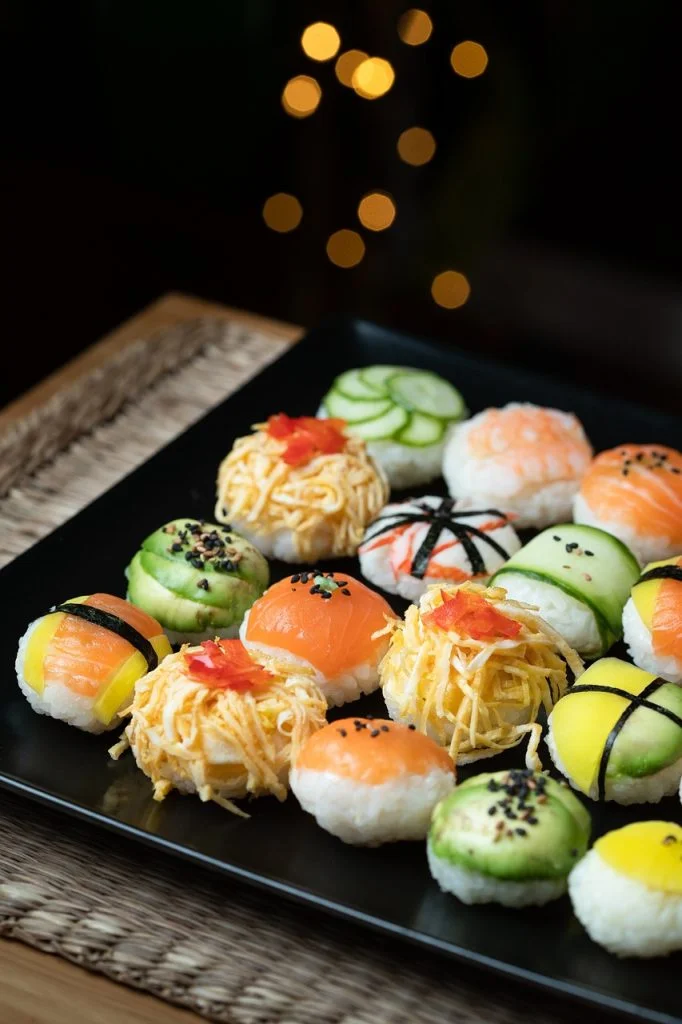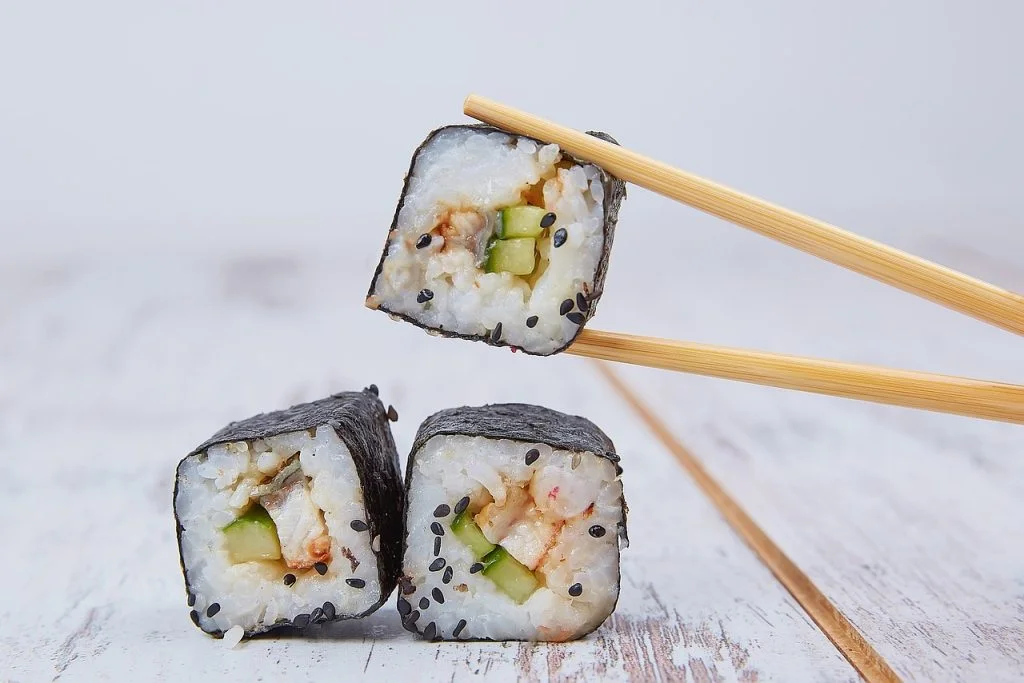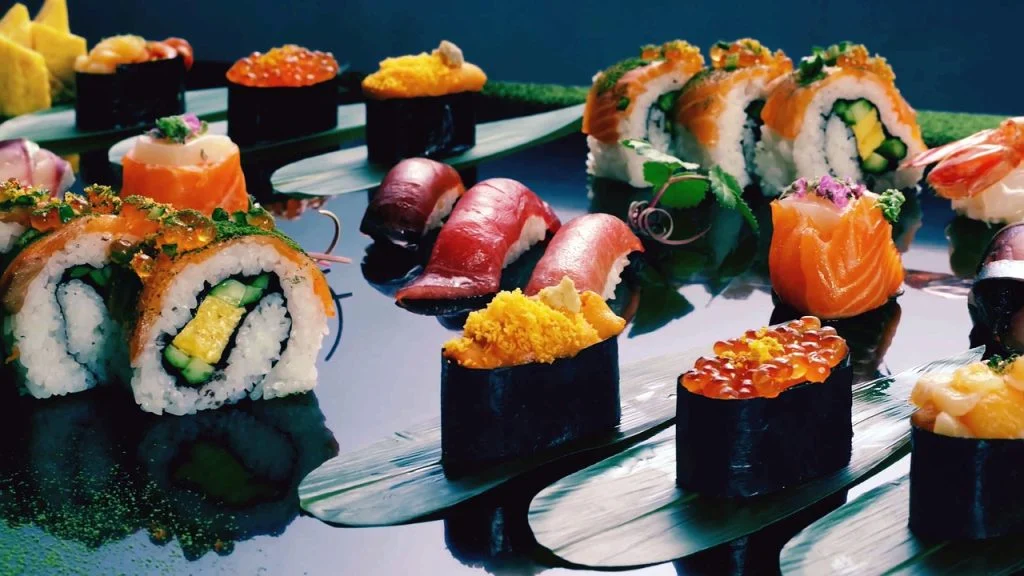Welcome aboard the sushi express! Imagine, if you will, a world where tiny rice beds snugly cradle slices of fish, where seaweed isn’t just something you avoid at the beach, and where a ‘California roll‘ isn’t a dance move. That’s right, we’re talking about sushi – the culinary rollercoaster that took the world by storm.
Now, you might be wondering, ‘How did raw fish become a global sensation?‘ Buckle up, because we’re about to dive into some amazing sushi facts that’ll take you through the fascinating world of sushi. And hey, have you ever tried to eat sushi with chopsticks while laughing? It’s a challenge you might soon face!
Sushi is not just food, it’s an art form.
Nobu Matsuhisa
Sushi Facts
Before we dive into the fascinating world of sushi, a reminder: there’s a quiz at the bottom of this article. So, keep your eyes peeled and your mind sharp as we roll through these facts!
- Sushi originally referred to fermented fish preserved in rice, a method dating back to Southeast Asia in the second century A.D.
- In the Edo period (1603–1868), sushi began to be eaten with vinegared rice in Japan.
- The word “sushi” actually refers to rice seasoned with vinegar, sugar, and salt.
- Nigiri sushi, slices of fish on top of rice, was developed in Tokyo (formerly Edo) in the 1820s.
- Sashimi is often confused with sushi, but it’s just thinly sliced raw fish without rice.
- Bluefin tuna, known as “otoro”, is one of the most expensive and desired types of sushi fish.
- Maki sushi is the roll form of sushi, typically wrapped in seaweed (nori).
- In Japan, wasabi is traditionally put between the fish and rice, not mixed into the soy sauce.
- Temaki sushi, a cone-shaped hand roll, is a more casual and easy-to-eat form of sushi.
- California rolls, with crab and avocado, were actually invented in Los Angeles, not Japan.
- Conveyor belt sushi restaurants, or kaiten-zushi, became popular in Japan in the 1950s.
- In traditional sushi preparation, chefs spend years learning how to properly prepare rice and fish.
- Fugu (pufferfish) sushi is a delicacy but can be deadly if not prepared correctly.

- Sushi chefs often use a special type of red vinegar made from sake lees in the rice.
- Chirashi sushi is a bowl of sushi rice topped with a variety of raw fish and garnishes.
- Omakase means ‘I leave it up to you’ and refers to a meal consisting of dishes selected by the sushi chef.
- Gunkan-maki, or battleship sushi, is a type of sushi with a loose topping secured by a strip of nori.
- Soy sauce for sushi is traditionally lighter and sweeter than regular soy sauce.
- The use of pickled ginger, or gari, as a palate cleanser between sushi pieces is a common practice.
- Aburi sushi refers to sushi where the fish is partially grilled (torched) and partially raw.
- Sea urchin sushi, known as uni, is a delicacy known for its rich, creamy texture and strong flavor.
- Traditionally, sushi chefs undergo up to 10 years of training before becoming fully qualified.
- Eel sushi, known as unagi (freshwater) and anago (saltwater), is often served with a sweet glaze.
- Vegetarian sushi, using ingredients like cucumber, avocado, and pickled radish, is increasingly popular.
- Sushi rice is prepared with a precise balance of sweetness, sourness, and saltiness.
- The first sushi restaurant in the United States opened in Los Angeles in the 1960s.
- Narezushi, the earliest form of sushi, involved fermenting fish with salt and rice for months.
- Philadelphia rolls, with smoked salmon and cream cheese, reflect Western adaptations of sushi.

- The term sushi chef is traditionally referred to in Japanese as “itamae”, meaning ‘in front of the board’. This doesn’t mean all chefs are referred as itamae.
- Kappamaki, a cucumber sushi roll, is named after a Japanese water imp that loves cucumbers.
- Inari sushi consists of sushi rice stuffed into a pouch of sweet, fried tofu.
- The speed of conveyor belt sushi varies depending on the time of day and the restaurant.
- Ikura (salmon roe) sushi is known for its bright orange color and burst-in-your-mouth texture.
- Sake, a type of rice wine, is commonly enjoyed with sushi.
- Sushi rice should be at body temperature when served, enhancing its flavor and texture.
- Tekkamaki is a tuna roll named for its resemblance to iron (tekketsu) in color.
- Dragon rolls are an elaborate type of sushi often topped with avocado and eel.
- Yubari King melon, a rare and expensive Japanese fruit, is sometimes used in luxury sushi dishes.

- Aji (horse mackerel) is a popular fish in traditional Edo-style sushi.
- Sushi-grade fish refers to fish that has been frozen to kill parasites, making it safe for raw consumption.
- Green tea, or agari, is commonly served in sushi restaurants to cleanse the palate.
- Sushi etiquette suggests eating nigiri sushi in one bite for the best flavor experience.
- The use of luxury ingredients like gold leaf and caviar in sushi is a modern innovation.
- Rainbow rolls are a type of sushi roll decorated with multiple types of fish and avocado.
- A5 Wagyu beef, known for its marbling, is sometimes used in high-end sushi dishes.
- Shari refers to sushi rice and is the foundation of all sushi dishes.
- Sushi robots are increasingly used in restaurants and factories for efficient sushi production.
- Squid and octopus are common ingredients in sushi, often prepared with a tenderizing technique.
- Seasonality plays a crucial role in sushi, with chefs selecting fish based on its peak flavor during the year.
- Sustainable sushi practices, like using farm-raised or eco-friendly fish, are growing in popularity.
Sushi Myths

After reading all these sushi fun facts, now it’s time to uncover the truth behind some classic myths about the topic.
- Sushi Means Raw Fish
Sushi actually refers to rice seasoned with vinegar, sugar, and salt. The raw fish component, often associated with sushi, is called “sashimi.” So, when you’re enjoying sushi, it’s really about the rice, not just the fish! - Sushi is Always Made with Seafood
Not necessarily! There are many types of sushi that contain cooked ingredients, vegetables, or even tropical fruits. Cucumber rolls (kappamaki) and egg sushi (tamagoyaki) are popular non-seafood options. - Sushi Must Be Eaten with Chopsticks
In Japan, it’s perfectly acceptable to eat sushi with your hands, especially when it comes to nigiri (a slice of fish over rice). So, feel free to ditch the chopsticks if that’s more comfortable for you. - Sushi Rice is Just Ordinary Rice
Sushi rice is a special type of rice known as shari. It’s seasoned with a mix of vinegar, sugar, and salt, which gives it a unique flavor and texture. This is what makes sushi rice different from your everyday steamed rice. - Wasabi and Soy Sauce Should Be Mixed Together
Traditional sushi etiquette suggests enjoying them separately. Wasabi should be placed directly on the sushi piece, while soy sauce is for dipping. Mixing them together can overpower the delicate flavors of the sushi.
No products found.
Sushi Quotes

Let me share with you five of my favorite quotes about sushi. Let me know which one is your favorite in the comments.
In sushi, as in life, balance is key.
Masaharu Morimoto
Masaharu Morimoto, a famous Japanese chef known for his unique style of fusion cuisine, highlights the importance of balance in sushi, relating it to life’s principles.
Eating sushi is a journey to experience, not just a meal.
Jiro Ono
Jiro Ono, a sushi master and the subject of the documentary “Jiro Dreams of Sushi,” suggests that enjoying sushi is about the experience and journey, not just the food itself.
Sushi is harmony in simplicity.
Sukiyabashi Jiro
Sukiyabashi Jiro, another celebrated sushi chef, points out how sushi represents harmony and simplicity, focusing on the essential qualities of the ingredients.
Every sushi piece tells a story.
Yoshikazu Ono
Yoshikazu Ono, son of Jiro Ono and a skilled sushi chef in his own right, implies that each piece of sushi has its own unique narrative and craftsmanship.
Sushi is a celebration of purity and simplicity.
David Chang
David Chang, an American restaurateur and TV personality known for his innovative approach to cuisine, describes sushi as a celebration of the pure and simple flavors and textures in food.
Sushi FAQ

I hope you enjoyed those bite-sized quotes, because now it’s time for the FAQ section. Read carefully, as this is the last piece of information you will get before the quiz.
- Are Sushi Rolls Healthy?
Absolutely, sushi rolls can be a healthy choice! They often contain fresh fish, which is a great source of protein and omega-3 fatty acids. The seaweed (nori) wrapped around the sushi is also packed with vitamins and minerals. However, keep an eye on rolls with added sauces or tempura, as these can bump up the calorie count. - Can Sushi Make You Sick?
It’s possible, but not common if you’re eating at reputable places. The risk comes from raw fish that may harbor parasites or bacteria. To minimize this risk, eat sushi from trustworthy restaurants that follow strict food safety protocols. Also, pregnant women and people with compromised immune systems should be more cautious. - How is Sushi Made?
Sushi making is an art! It starts with sushi rice, which is seasoned with a mix of vinegar, sugar, and salt. Then, chefs carefully slice fresh fish or other toppings. For rolls, the rice and fish are wrapped in nori seaweed, often with additional ingredients like cucumber or avocado. Finally, it’s sliced into bite-sized pieces. - Are Sushi Bowls Healthy?
Yes, sushi bowls can be a healthy meal! They usually consist of sushi rice topped with various fresh ingredients like fish, vegetables, and sometimes fruits. Just like sushi rolls, the healthiness depends on what you put in your bowl. Go for lots of veggies and lean protein, and be mindful of high-calorie toppings. - Can Sushi be Refrigerated?
Sushi is best enjoyed fresh, but yes, you can refrigerate it. If you have leftovers, wrap them tightly and store them in the fridge. Consume them within 24 hours for safety and best taste. Remember, the rice might harden a bit, and the texture of the fish can change when chilled.
No products found.
Sushi Trivia

Dive into our sushi quiz! But beware; get too many answers wrong, and you might just find yourself turning into a human-sized wasabi!
Conclusion
As we wrap up (pun intended), let’s reflect on our sushi journey. We’ve dived into the world of raw fish and emerged wiser and, hopefully, hungrier. Did you know sushi chefs train for years to master their craft? That’s dedication!
So next time you bite into that spicy tuna roll, ponder this: Is there a sushi roll out there that could change your life? Maybe one that sings ballads? Let us know your dream sushi roll!
4 Sources Used For This ArticleThe World Of Famous Japanese Food Sushi – Tan Pub
Is All Sushi Raw? Debunking the Myth and Clarifying the Truth – All Day I Eat
25 Fun Facts About Sushi You Should Know – I Fun Fact


